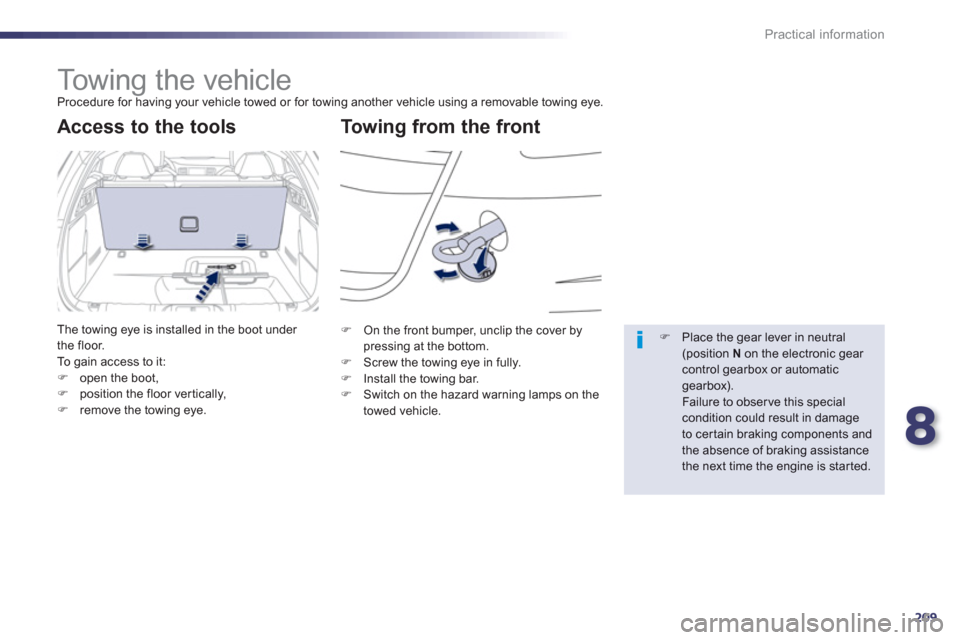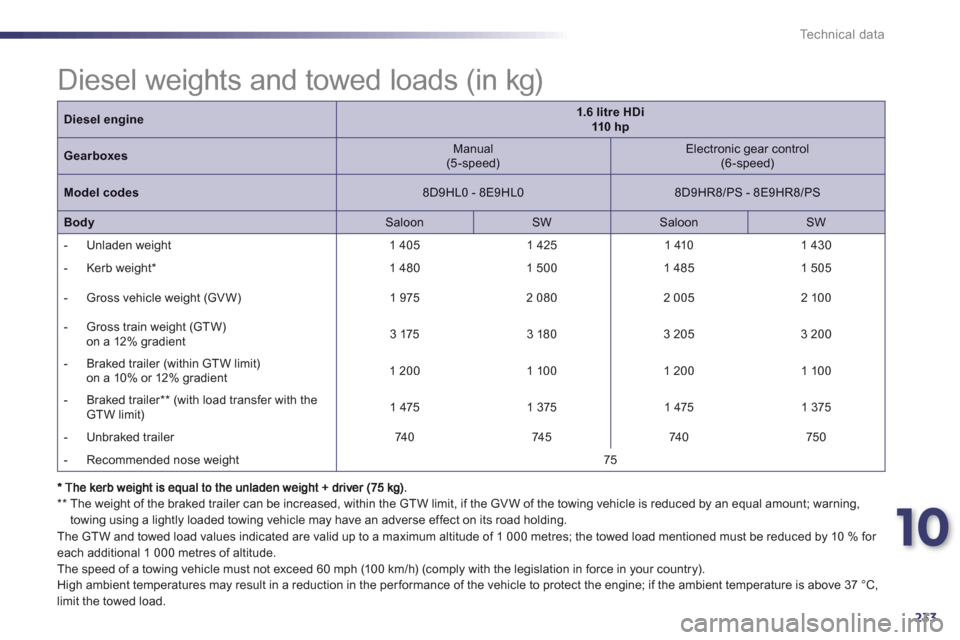2013 Peugeot 508 Hybrid towing
[x] Cancel search: towingPage 211 of 340

8
209
Practical information
Towing the vehicle
Procedure for having your vehicle towed or for towing another vehicle using a removable towing eye.
To w i ng from the front Access to the tools
The towing eye is installed in the boot under
the floor.
To gain access to it: F
open the boot, F
position the floor vertically,F
remove the towing eye.F
On the front bumper, unclip the cover by
pressing at the bottom.FScrew the towing eye in fully.FInstall the towing bar.FSwitch on the hazard warning lamps on the
towed vehicle.
F Place the gear lever in neutral (position Non the electronic gear control gearbox or automaticgearbox). Failure to obser ve this specialcondition could result in damage to cer tain braking components andthe absence of braking assistance the next time the engine is started.
Page 212 of 340

210
Practical information
General
recommendations
Observe the legislation in force in your country.Ensure that the weight of the towing vehicle is higher than that of the towedvehicle.The person at the wheel of the towedvehicle must have a valid driving licence.When towing a vehicle with all four wheels on the ground, always use an approved towing bar; rope and straps are prohibited. When towing a vehicle with the engine off, there is no longer any power assistance for braking or steering.In the following cases, you must always call on a professional recovery service:- vehicle broken down on a motor wayor fast road,
- 4 wheel drive vehicle, - when it is not possible to put the gearbox into neutral, unlock thesteering, or release the parkingbrake, - towing with only two wheels on theground, - where there is no approved towing bar available...
To w i ng from the rear
FOn the rear bumper, unclip the cover by pressing at the bottom. FScrew the towing eye in fully. FInstall the towing bar.FSwitch on the hazard warning lamps on the
towed vehicle.
Page 213 of 340

8
211
Practical information
Towing a trailer
We recommend the use of genuine PEUGEOT towbars and their harnesses that have been tested and approvedfrom the design stage of your vehicle, and that the fitting of the towbar isentrusted to a PEUGEOT dealer or aqualified workshop.
If the towbar is not fitted by a PEUGEOT dealer, it is imperative that itis fitted in accordance with the vehicle manufacturer's instructions.
T
owbar suitable for the attachment of atrailer or installation of a bicycle carrier, with
additional lighting and signalling.
Blanking cover
When towing, you must remove the blanking cover if your vehicle has one.
Contact a PEUGEOT dealer or a qualified
workshop for this.
Driving with a trailer places greater demands on the towing vehicle and the driver must take par ticular care.
Your vehicle is primaril
y designed for
transporting people and luggage, but it mayalso be used for towing a trailer.
Page 214 of 340

212
Practical information
Driving advice
Distribution of loads
FDistribute the load in the trailer so that theheaviest items are as close as possible to
the axle and the nose weight approaches
the maximum permitted without
excee
ding it.
Air density decreases with altitude, thus reducingengine performance. Above 1 000 metres, the maximum towed load must be reduced by 10 %
for every 1 000 metres of altitude.
Side wind
FTake into account the increased sensitivity
to side wind.
Cooling
To w i ng a trailer on a slope increases the
temperature of the coolant.
As the fan is electricall
y controlled, its cooling capacity is not dependent on the engine speed.
F
To lower the engine speed, reduce your speed.
The maximum towed load on a long incline
depends on the
gradient and the ambient
temperature.
In all cases, keep a check on the coolant
temperature.
FIf the warning lamp and the
STOP warning lamp come on, stop the vehicle and switch off
the engine as soon as possible.
Braking
To w i ng a trailer increases the braking distance.
To avoid overheating of the brakes on a longmountain type of descent, the use of engine braking is recommended.
Tyres
F
Check the tyre pressures of the towingvehicle and of the trailer, obser ving the recommended pressures.
Lighting
F
Check the electrical lighting and signalling on the trailer.
The rear parking sensors will be deactivated automatically if a genuine PEUGEOT towbar is used.
R
efer to the "Technical Data" section for details
of the weights and towed loads which apply to your vehicle.
Page 230 of 340

228
Technical data
*
The kerb weight is equal to the unladen weight + driver (75 kg). **
The weight of the braked trailer can be increased, within the GTW limit, if the GVW of the towing vehicle is reduced by an equal amount; warning,
towing using a lightly loaded towing vehicle may have an adverse effect on its road holding.
Petrol weights and towed loads (in kg)
The GTW and towed load values indicated are valid up to a maximum altitude of 1 000 metres; the towed load mentioned must be reduced by 10 % for each additional 1 000 metres of altitude.
The speed of a towing vehicle must not exceed 60 mph (10 0 km/h) (comply with the legislation in force in your country).
High ambient temperatures may result in a reduction in the performance of the vehicle to protect the engine; if the ambient temperature is above 37 °C,
limit the towed load.
Petrol engines1.6 litre V Ti120 hp1.6 litre THP156 hp
GearboxesElectronic gear control(6-speed)
Manual(6-speed)
Automatic(6-speed)
Model codes
8D5FH8/P - 8E5FH8/P 8D5FS8/P - 8E5FS8/P 8D5FV8 - 8E5FV8
8D5FNA - 8E5FNA 8D5FVA - 8E5FVA
BodySaloon
SW
Saloon SW
Saloon
SW
- Unladen wei
ght 1 390
1 410
1 400
1 420
1 410
1 430
- Kerb weight *
1 465 1 485
1 475 1 495
1 485
1 505
- Gross vehicle wei
ght (GV W)
1 945 2 0551 9952 080
2 015 2 10 0
- Gross train weight (GTW)
on a 12 % gradient 3 3453 355
3 595
3 5803 515
3 600
- Braked trailer
(within GTW limit) on a 10 % or 12 % gradient1 400
1 3001 6001 500
1 600
1 500
- Braked trailer ** (with load transfer within the
GTW limit) 1 675 1 575 1 875 1 7751 875 1 775
-
Unbraked trailer
730
740735
745
740
750
- Recommended nose weight 7575
Page 231 of 340

10
229
Technical data
Petrol engine1.6 litre THP 160 hp
Gearbox
Manual(6-speed)
Model code
-
Body
Saloon
SW
- Unladen wei
ght -
-
- Kerb weight
*-
-
- Gross vehicle wei
ght (GV W)
-
-
-
Gross train weight (GTW)
on a 12 % gradient --
- Braked trailer (within GTW limit) on a 10 % or 12 % gradient--
- Braked trailer ** (with load transfer within the
GTW limit) -
-
-
Unbraked trailer --
- Recommended nose weight
-
*
The kerb weight is equal to the unladen weight + driver (75 kg). **
The weight of the braked trailer can be increased, within the GTW limit, if the GVW of the towing vehicle is reduced by an equal amount; warning,
towing using a lightly loaded towing vehicle may have an adverse effect on its road holding.
Petrol weights and towed loads (in kg)
The GTW and towed load values indicated are valid up to a maximum altitude of 1 000 metres; the towed load mentioned must be reduced by 10 % for each additional 1 000 metres of altitude.
The speed of a towing vehicle must not exceed 60 mph (10 0 km/h) (comply with the legislation in force in your country).
High ambient temperatures may result in a reduction in the performance of the vehicle to protect the engine; if the ambient temperature is above 37 °C,
limit the towed load.
Page 235 of 340

10
233
Technical data
**
The weight of the braked trailer can be increased, within the GTW limit, if the GVW of the towing vehicle is reduced by an equal amount; warning,
towing using a lightly loaded towing vehicle may have an adverse effect on its road holding.
The
GTW and towed load values indicated are valid up to a maximum altitude of 1 000 metres; the towed load mentioned must be reduced by 10 % for each additional 1 000 metres of altitude.
The speed of a towing vehicle must not exceed 60 mph (10 0 km/h) (comply with the legislation in force in your country).
High ambient temperatures may result in a reduction in the performance of the vehicle to protect the engine; if the ambient temperature is above 37 °C,
limit the towed load.
Diesel weights and towed loads (in kg)
Diesel engine1.6 litre HDi 110 hp
Gearboxes
Manual(5-speed)
Electronic gear control (6-speed)
Model codes8D9HL0 - 8E9HL0
8D9HR8/PS - 8E9HR8/PS
BodySaloonSW
SaloonSW
- Unladen wei
ght 1 4051 425 1 410
1 430
- Kerb weight
*
1 480 1 500
1 485 1 505
- Gross vehicle wei
ght (GV W)
1 975 2 080
2 005 2 10 0
-
Gross train weight (GTW)
on a 12% gradient 3 175
3 180
3 205
3 200
- Braked trailer
(within GTW limit) on a 10% or 12% gradient
1 200
1 100
1 200
1 100
- Braked trailer **
(with load transfer with the
GTW limit) 1 475
1 375
1 475
1 375
-
Unbraked trailer
740
745740
750
- Recommended nose wei
ght
75
Page 236 of 340

234
Technical data
2.0 litre HDi140 hp2.0 litre HDi163 hp
GearboxesManual (6-speed)
Automatic
(6-speed)
Manual (6-speed)
Model codes
8DRHR8 - 8ERHR8
8DRHF8 - 8ERHF8
8DRHHA - 8ERHHA 8DRHDA - 8ERHDA
8DRHH8 - 8ERHH8
OutlineSaloon
SW
Saloon SW
Saloon
SW
- Unladen wei
ght1 430
1 500
1 520
1 540
1 480
1 500
- Kerb weight *
1 505
1 575
1 595
1 615 1 555 1 575
- Gross vehicle wei
ght (GV W)
2 065 2 1402 105 2 18 0
2 075 2 140
-
Gross train weight (GTW)
on a 12% gradient3 665 3 640
3 405
3 380
3 675
3 640
- Braked trailer (within GTW limit) on a 10% or 12% gradient
1 600
1 5001 300
1 200
1 600
1 500
- Braked trailer ** (with load transfer with the
GTW limit) 1 8751 775
1 575
1 4751 875
1 775
-
Unbraked trailer
750
750
- Recommended nose wei
ght 7575
*
The kerb weight is equal to the unladen weight + driver (75 kg). **
The weight of the braked trailer can be increased, within the GTW limit, if the GVW of the towing vehicle is reduced by an equal amount; warning,
towing using a lightly loaded towing vehicle may have an adverse effect on its road holding.
The
GTW and towed load values indicated are valid up to a maximum altitude of 1 000 metres; the towed load mentioned must be reduced by 10 % for each additional 1 000 metres of altitude.
The speed of a towing vehicle must not exceed 60 mph (10 0 km/h) (comply with the legislation in force in your country).
High ambient temperatures may result in a reduction in the performance of the vehicle to protect the engine; if the ambient temperature is above 37 °C,
limit the towed load.
Diesel weights and towed loads (in kg)